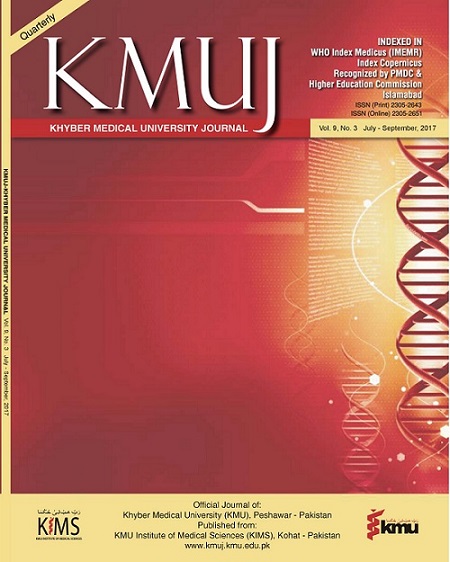CAUSATIVE AGENTS OF URINARY TRACT INFECTION IN DIABETIC PATIENTS AND THEIR PATTERN OF ANTIBIOTIC SUSCEPTIBILITY
Main Article Content
Abstract
ABSTRACT
OBJECTIVES: To determine the etiologic agents of urinary tract infection (UTI) and their antibiotic susceptibility patterns among diabetic patients.
METHODS: This cross-sectional observational study was conducted from 1st August 2016 to 28th Feb 2017 at Cantonment General Hospital Rawalpindi, Pakistan. A consecutive non-probability sampling technique was used to screen diabetic patients for UTIs irrespective of their symptoms. Subjects from both genders and aged more than 18 years were included. Urine cultures were taken and uropathogens were isolated and tested for drug susceptibility following standard laboratory procedures.
RESULTS: Out of 209 diabetic patients, 106 (50.7%) had culture positive UTI, 77/106 (72.6%) were females. Mean age of patients with UTI was 49.9±9.80 years. Ninety-eight (93.5%) had type 2 diabetes and with a mean duration of 8.25±3.78 years. Mean HbA1c level was 9.63±2.001%. Thirty-five (33%) patients had HbA1c >11, 52 (49.1%) patients had HbA1c values ranging between 7 to 11% and 19 (17.8%) patients had HbA1c level of <7%. Eschericia coli (E coli) was the most common uropathogen (80%) followed by Enterobacter (7.6%), citrobacter (6.7%), morganella (4.8%) and pseudomonas (1%). No gram positive bacteria were isolated. Fosfomycin was 100% sensitive against all uropathogens. Meropenum, piperacillin-Tazobactum and cefoperazone-salbactum were 91.4%, 88.6% and 86.7% sensitive respectively, whereas amikacin was 72.4% sensitive. Chloramphenicol, doxycycline and amoxicillin/culvunate showed sensitivity of 66.7%, 61% and 40% respectively. Cephalosporins and quinolones were least sensitive classes.
CONCLUSION: E coli were the most common uropathogens in diabetics. Fosfomycin, Meropenum, piperacillin-Tazobactum and cefoperazone-salbactum had good sensitivity profile against uropathogens in diabetics.
KEY WORDS: Diabetes Mellitus (MeSH), Urinary Tract Infections (MeSH), Antibiotics (MeSH)Article Details
Work published in KMUJ is licensed under a
Creative Commons Attribution 4.0 License
Authors are permitted and encouraged to post their work online (e.g., in institutional repositories or on their website) prior to and during the submission process, as it can lead to productive exchanges, as well as earlier and greater citation of published work.
(e.g., in institutional repositories or on their website) prior to and during the submission process, as it can lead to productive exchanges, as well as earlier and greater citation of published work.
References
REFERENCES
Chiu CC, Lin TC, Wu RX, Yang YS, Hsiao PJ, Lee Y, et al. Etiologies of community-onset urinary tract infections requiring hospitalization and antimicrobial susceptibilities of causative microorganisms. J Microbiol Immunol Infect 2017;50(6):879-85. DOI: 10.1016/j.jmii.2016.08.008.
Nigussie D, Amsalu A. Prevalence of uropathogen and their antibiotic resistance pattern among diabetic patients. Turk J Urol 2017;43(1):85-92. DOI: 10.5152/tud.2016.86155.
Aswani SM, Chandrashekar UK, Shivashankara K, Pruthvi B. Clinical profile of urinary tract infections in diabetics and non-diabetics. Australas Med J 2014;7(1):29–34. DOI: 10.4066/AMJ.2014.1906.
Shill MC, Huda NH, Moain FB, Karmakar UK. Prevalence of Uropathogens in Diabetic Patients and Their Corresponding Resistance Pattern: Results of a Survey Conducted at Diagnostic Centers in Dhaka, Bangladesh. Oman Med J 2010;25(4):282-5. DOI: 10.5001/omj.2010.82.
Mamuye Y. Antibiotic Resistance Patterns of Common Gram-negative Uropathogens in St. Paul’s Hospital Millennium Medical College. Ethiop J Health Sci 2016;26(2):93-100.
Ramana BV, Chaudhury A. Prevalence of uropathogens in diabetic patients and their resistance pattern at a tertiary care centre in south India. Int J Biol Med Res 2012;3(1):1433-5.
Geerlings SE. Urinary tract infections in patients with diabetes mellitus: epidemiology, pathogenesis and treatment. Int J Antimicrob Agents 2008;3(Suppl 1):S54-7.
Sowmya S, Lakshmidevi N. Prevalence and incidence of urinary tract infection among diabetic patients in Mysore. Int J Recent Sci Res 2013;4:1651-65.
Sharma V, Gupta V, Mittal M. Prevalence of uropathogens in diabetic patients and their antimicrobial susceptibility pattern. Natl J lab Med 2012;1(1):26-8.
Longdoh NA, Assob JCN, Nsagha SD, Nde PF, Kamgo HLF, Nkume AF, et al. Uropathogens from diabetic patients with asymptomatic bacteriuria and urinary tract infections. West London Med J 2013;5(1):7-14.
Acharya D, Bogati B, Shrestha GT, Gyawali P. Diabetes mellitus and Urinary Tract Infection: Spectrum of Uropathogens and their Antibiotic Sensitivity Pattern. J Manmohan Mem Inst Health Sci 2015;1(4):24-8.
Sewify M, Nair S, Warsame S, Murad M, Alhubail A, Behbehani K, et al. Prevalence of urinary tract infection and antimicrobial susceptibility among diabetic patients with controlled and uncontrolled glycemia in Kuwait. J Diabetes Res 2016;2016:6573215. DOI: 10.1155/2016/6573215.
Shah SF, Paracha SA. Gross pyuric diabetics with uncontrolled glycemia: Pattern of pathogenic organisms and antimicrobial susceptibility. Khyber Med Univ J 2016;8(4):189-93.
Saleem M, Daniel B. Prevalence of urinary tract infection among patients with diabetes in Bangalore city. Int J Emerg Sci 2011;1(2):133-42.
MacVane SH, Tuttle LO, Nicolau DP. Impact of extended-spectrum
Sibi G, Devi AP, Fouzia K, Patil BR. Prevalence, microbiologic profile of urinary tract infection and its treatment with trimethoprim in diabetic patients. Res J Microbiol 2011;6(6):543-51. DOI: 10.3923/jm.2011.543.551.
